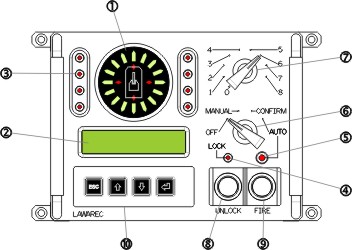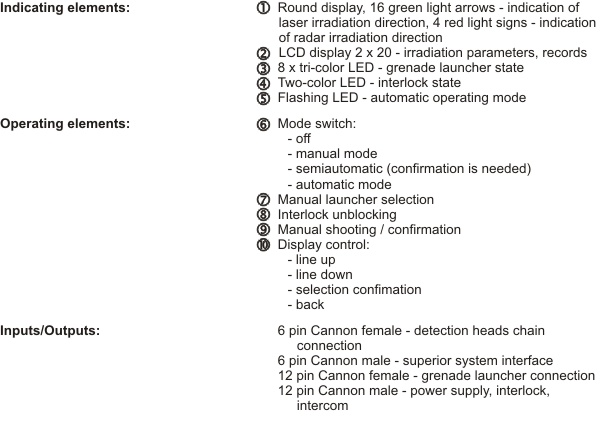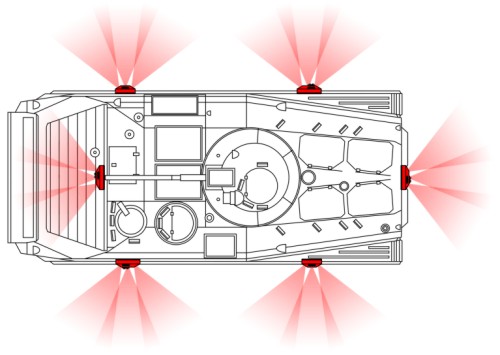
|
Laser Technology - Defence and Security Applications |
|
| PRODUCTS | SERVICES | ABOUT US | EVENTS | CONTACT |
|
|
||
|
The LAWAREC BRICK is a distributed modular detection system used for the protection of mobile and stationary objects against laser rangefinders, target designators and beamriders.
USE AND DESCRIPTION: Modular system of detection is primarily aimed at the protection of small and medium-large, mobile objects against observation, recognition by laser and microwave means as well as laser aimed and guided weapon systems. The system consists of two types of detection modules, which contain either only the laser or a combination of laser and microwave detectors. The modules are connected by a daisy-chain with the central unit using a neuron network, which guarantees system reliability even in the case of partial damage. Data from each incident is transfered to the central unit with an accurate time-stamp, that enables exclusion of the signal from being reflected by the surrounding terrain. For this reason all the modules contain an autonomous, accurately synchronized time base. Modules are installed in the approximate middle of the object's height, evenly distributed around their periphery so that it does not conflict with other functional systems (observation systems, weapon systems etc.). The standard configuration is four laser or four laser/radar modules for smaller objects and a combination of four laser/radar modules situated on the front, back and sides of the object, complemented by two laser modules on sides for larger objects. This configuration enables thourough coverage of the object in terms of detection. The central unit located inside the object processes incoming information from individual modules, evaluates them, and then offers the operator a summary of the laser and radar activities of the enemy. Simultaneously it suggests a solution to the actual situation (like firing smoke grenades) which in semi-automatic mode waits for the operator's confirmation and in automatic mode directly executes the countermeasures to defeat enemy activities. The central unit indicates the actual state in real time, and sends this information through the serial link to the superior system; it also sends an audio signal indicating a threat to the intercom. Simultaneously, it saves all incidencies to the internal memory for later review. Smoke grenade launchers are connected to the central unit (max. two sets, 8 smoke grenades each) to make a smoke screen between the protected object and the source of irradiation. The central unit also contains security circuits (interlock) as protection against unwanted firing of smoke grenades in the case of an open vehicle hatchway, avoiding injury to the persons on the object. This protection can be used in case of the necessity of manually blocked for the purpose of manual grenades firing. In automatic mode (combat situation), the protection is blocked permanently. To switch the automatic mode on, it is necessary to keep the algorithm of switching in order to avoid accidental unwanted switching to this mode by reason of the operators' safety against unwanted grenade firing.
Additionally, the central unit allows manual firing of selected smoke grenades in case of the complete failure of internal electronics. This mode, with the indication of the grenade launcher's status is fully autonomous and independent of the electronic circuits of the unit. That means that for the operation in manual mode, only board 24 V is needed.
|
|
Module of laser detection Spectral Range: Number of receivers: Nember of detection sectors: Resolution in azimuth: Resolution in elevation: Pulse width: Repeating frequency: Sensitivity: Recognition: Number of modules in system Weight Operating temperature: Module of laser and radar detection Radar section Spectral range: Minimum sensitivity: Pulse width: Repeating frequency: Laser section Spectral range: Number of receivers: Number of detection sectors: Resolution in azimuth: Resolution in elevation: Pulse width: Repating frequency: Sensitivity: Recognition: Number of modules in system: Weight: Operating temperature: Module of elimination of own rangefinder Optical input: Electrical input: |
750 ÷ 1750 nm (standard) 400 ÷ 1750 nm, 750 ÷ 2200 nm, 400 ÷ 2200 nm (optional) 4 11 (5+5+1) in azimuth, 3 in elevation 5 x 15° = 75° (+ 2 x 15° - join to next modules) -20° ÷ +102° (-20° ÷ +42°; +42° ÷ +55°; +55° ÷ +102°) 10 ÷ 500 ns 40 kHz max. 10 W/m2 monopulse, target designator, beam rider 4/6 standard, depends on configuration, max 12 560 g -40 ÷ 60°C 8 ÷ 18 GHz -51 dBm 100 ns min. 10 Hz ÷ 20 kHz 750 ÷ 1750 nm (standard) 400 ÷ 1750 nm, 750 ÷ 2200 nm, 400 ÷ 2200 nm (optional) 4 11 (5+5+1) in azimuth, 3 in elevation 5 x 15° = 75° (+ 2 x 15° - join to next modules) -20° ÷ +102° (-20° ÷ +42°; +42° ÷ +55°; +55° ÷ +102°) 10 ÷ 500 ns 40 kHz max. 10 W/m2 monopulse, target designator, beam rider 4/6 standard, depends on configuration, max 12 680 g -40 ÷ 60°C optical fibre 700nm ÷ 1750nm, 10 ÷ 500ns TTL edge 0/1 100ns ÷ 1 us, galvanic isolated |
|
|
||
|
LAWAREC BRICK-P SET
One LAWAREC BRICK-P set contains: |
|
|




 download pdf
download pdf